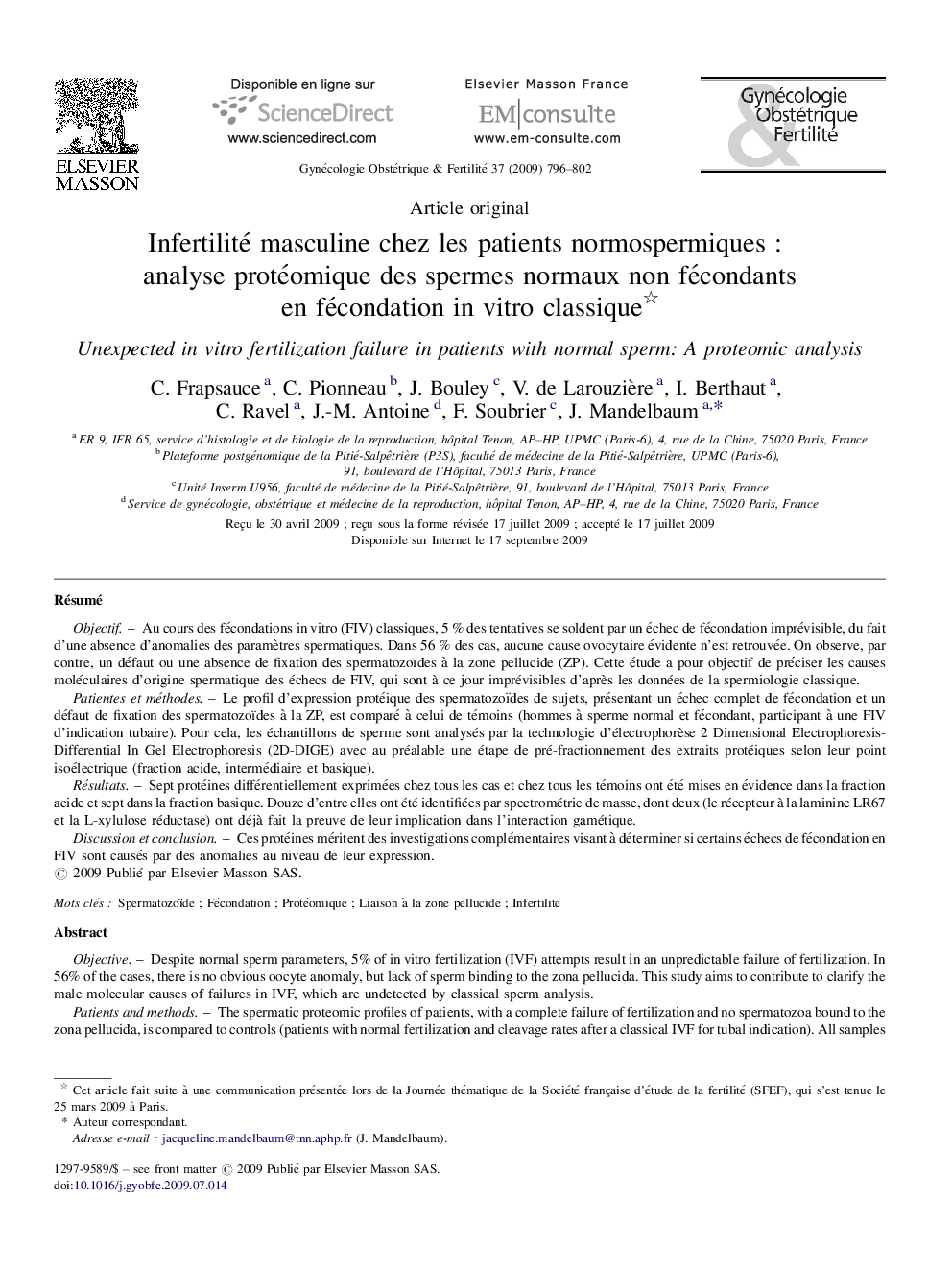| کد مقاله | کد نشریه | سال انتشار | مقاله انگلیسی | نسخه تمام متن |
|---|---|---|---|---|
| 3952548 | 1254939 | 2009 | 7 صفحه PDF | دانلود رایگان |

RésuméObjectifAu cours des fécondations in vitro (FIV) classiques, 5 % des tentatives se soldent par un échec de fécondation imprévisible, du fait d’une absence d’anomalies des paramètres spermatiques. Dans 56 % des cas, aucune cause ovocytaire évidente n’est retrouvée. On observe, par contre, un défaut ou une absence de fixation des spermatozoïdes à la zone pellucide (ZP). Cette étude a pour objectif de préciser les causes moléculaires d’origine spermatique des échecs de FIV, qui sont à ce jour imprévisibles d’après les données de la spermiologie classique.Patientes et méthodesLe profil d’expression protéique des spermatozoïdes de sujets, présentant un échec complet de fécondation et un défaut de fixation des spermatozoïdes à la ZP, est comparé à celui de témoins (hommes à sperme normal et fécondant, participant à une FIV d’indication tubaire). Pour cela, les échantillons de sperme sont analysés par la technologie d’électrophorèse 2 Dimensional Electrophoresis-Differential In Gel Electrophoresis (2D-DIGE) avec au préalable une étape de pré-fractionnement des extraits protéiques selon leur point isoélectrique (fraction acide, intermédiaire et basique).RésultatsSept protéines différentiellement exprimées chez tous les cas et chez tous les témoins ont été mises en évidence dans la fraction acide et sept dans la fraction basique. Douze d’entre elles ont été identifiées par spectrométrie de masse, dont deux (le récepteur à la laminine LR67 et la L-xylulose réductase) ont déjà fait la preuve de leur implication dans l’interaction gamétique.Discussion et conclusionCes protéines méritent des investigations complémentaires visant à déterminer si certains échecs de fécondation en FIV sont causés par des anomalies au niveau de leur expression.
ObjectiveDespite normal sperm parameters, 5% of in vitro fertilization (IVF) attempts result in an unpredictable failure of fertilization. In 56% of the cases, there is no obvious oocyte anomaly, but lack of sperm binding to the zona pellucida. This study aims to contribute to clarify the male molecular causes of failures in IVF, which are undetected by classical sperm analysis.Patients and methodsThe spermatic proteomic profiles of patients, with a complete failure of fertilization and no spermatozoa bound to the zona pellucida, is compared to controls (patients with normal fertilization and cleavage rates after a classical IVF for tubal indication). All samples are analysed by 2 Dimensional Electrophoresis-Differential In Gel Electrophoresis (2DE-DIGE) after being divided into three fractions according to their isoelectric point (acid, intermediate and basic).ResultsFourteen proteins differentially expressed between all the cases and all the controls were highlighted. Twelve of these proteins were identified by mass spectrometry (six from the acid fraction and six from the basic fraction). Two of these proteins may have an interest in gametic interaction: the laminin receptor LR67 and the L-xylulose reductase.Discussion and conclusionMore investigation is needed to understand the involvement of the identified proteins in the IVF fertilization failure of the infertile patients in this study.
Journal: Gynécologie Obstétrique & Fertilité - Volume 37, Issue 10, October 2009, Pages 796–802